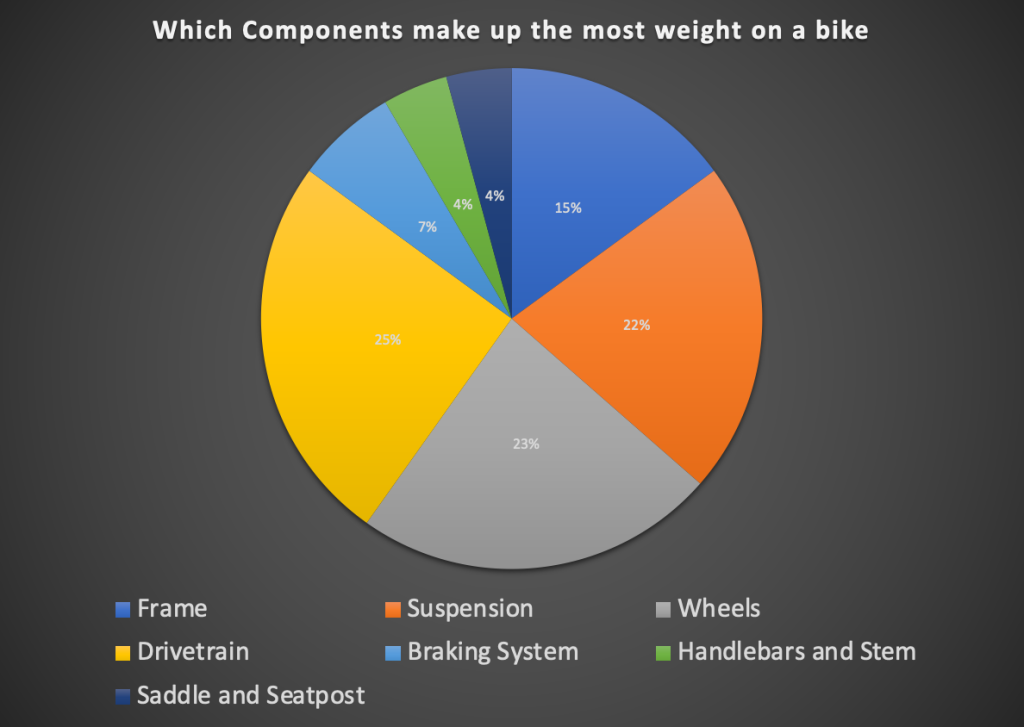How Much Do Mountain Bikes Weigh? (Does It Matter?)
In this article, we delve into how much mountain bikes weigh and give examples across various disciplines. In this comprehensive guide, we look at all the factors that influence weight and learn how you can optimize your bike’s performance.
So, let’s dive into the world of mountain bike weights and learn how the right balance can revolutionize your riding experience and elevate your performance on the trails.
- Factors Affecting Mountain Bike Weight
- How Much Do Mountain Bikes Weigh? (Average Weights)
- How to Choose the Right Mountain Bike Weight
- How To Reduce Mountain Bike Weight
- The Impact of Rider Weight on Mountain Bike Performance
- Does Mountain Bike Weight Actually Make a Difference?
- Sprung vs Unsprung Mass on Mountain Bikes
- Frequently Asked Questions
- Does bike weight really matter?
- How much weight can a mountain bike hold?
- Can a heavier rider use a lighter bike?
- What's a good weight for a Mountain Bike?
- What is the average weight of entry-level, mid-range, and high-end mountain bikes?
- How do different materials impact the weight of a mountain bike?
- Are lightweight mountain bikes more expensive?
- What factors affect mountain bike weight?
- How can I reduce the weight of my mountain bike?
- Does mountain bike weight impact performance?
- How does the weight of a mountain bike effect uphill climbing?
- Final Thoughts
Factors Affecting Mountain Bike Weight
Several factors influence the weight of mountain bikes. These factors include frame material, components, and bike type.
Frame Material
Mountain bike frames are typically made from one of the following materials:
Aluminum: Lightweight and affordable, aluminum is the most common material for mountain bike frames. An aluminum frame usually weighs between 2.5-4.5 pounds (1.1-2 kg).
Carbon Fiber: Extremely lightweight and stiff, carbon fiber is often found on high-end mountain bikes. A carbon fiber frame can weigh between 1.5-3.5 pounds (0.7-1.6 kg). Can You Trust Carbon Fibre Frames? (Explained)
Steel: Durable and strong, steel is typically heavier than other materials, making it less common on modern mountain bikes. Steel frames generally weigh between 4-7 pounds (1.8-3.2 kg).
Titanium: A rare and expensive material, titanium is lightweight, strong, and offers a comfortable ride. Titanium frames can weigh between 2.5-4.5 pounds (1.1-2 kg).
Components
Components such as the suspension, wheels, drivetrain, and braking system can also affect a mountain bike’s weight. High-quality components are generally lighter and more durable.
Bike Type
Mountain bikes come in several types, including cross-country, trail, enduro, and downhill. Each type has its own weight range due to differing designs and intended use.
How Much Do Mountain Bikes Weigh? (Average Weights)
Below are the average weights for various types of mountain bikes:
Cross-Country Bikes
Cross-country bikes are designed for speed and efficiency on various terrains. They typically weigh between 22-28 pounds (10-12.7 kg).
Trail Bikes
Trail bikes are versatile and suitable for a wide range of terrain. They generally weigh between 24-31 pounds (10.8-14 kg).
Enduro Bikes
Enduro bikes are designed for aggressive riding on technical descents and steep climbs. Their weight usually ranges from 28-35 pounds (12.7-15.8 kg).
Downhill Bikes
Downhill bikes are built for descending at high speeds on rough terrain. They are typically the heaviest, weighing between 35-42 pounds (15.8-19 kg).

How to Choose the Right Mountain Bike Weight
To choose the right mountain bike weight, consider the following:
- Riding Style: Determine your preferred riding style and choose a bike that aligns with it.
- Terrain: Consider the terrain you’ll be riding on most often and choose a bike designed for that environment.
- Budget: Lightweight bikes and components can be expensive. Establish your budget and find a bike that meets your weight preferences and financial constraints.
- Personal Preference: Ultimately, choose a bike that feels comfortable and enjoyable to ride.
How To Reduce Mountain Bike Weight
If you’re interested in reducing your mountain bike’s weight, consider these tips:
Upgrade Components
Invest in lightweight components such as wheels, tires, handlebars, and seat posts. Carbon fiber and high-quality aluminum components can help reduce weight without sacrificing performance.
Tubeless Tires
Switching to tubeless tires can save weight by eliminating the need for inner tubes. In addition to weight reduction, tubeless tires can also improve traction and reduce the risk of flats.
Folding vs Wire Bead Tires (Which To Choose)
Opt for a Single Chainring
If your riding style permits, consider switching to a single chainring drivetrain. This can help reduce weight by eliminating the front derailleur, extra chainring, and associated hardware.
Remove Unnecessary Accessories
Evaluate your bike for unnecessary accessories, such as water bottle cages, mudguards, or bike racks. Removing these items can contribute to a lighter bike.
The Impact of Rider Weight on Mountain Bike Performance

Rider weight can have a significant impact on mountain bike performance. Heavier riders may require sturdier frames and components to ensure durability and a comfortable ride. Conversely, lighter riders may benefit from lighter bikes that are easier to maneuver. Additionally, rider weight can affect suspension setup, requiring adjustments to ensure optimal performance on the trail.
Detailed Breakdown of what makes up the most weight:
In this section, we provide an in-depth look at the various components of a mountain bike and how they contribute to the overall weight.
Suspension
Suspension systems help absorb impacts and provide a smoother ride on rough terrain.
There are two main types of suspension systems:
Front Suspension (Hardtail): Hardtail mountain bikes have a suspension fork in the front, while the rear remains rigid. Front suspension forks generally weigh between 3-5 pounds (1.4-2.3 kg).
Full Suspension: Full suspension mountain bikes have suspension systems in both the front and rear, offering improved comfort and traction. Rear suspension components typically add 2-4 pounds (0.9-1.8 kg) to the bike’s weight.
Wheels
Wheels play a significant role in a mountain bike’s weight and performance. Lighter wheels can improve acceleration and maneuverability. A wheelset’s weight can vary depending on the material and design, with most mountain bike wheelsets weighing between 3.5-7 pounds (1.6-3.2 kg).
Drivetrain
The drivetrain includes the chain, cassette, crankset, derailleurs, and shifters. Drivetrain components can vary greatly in weight depending on their materials and construction. A complete drivetrain can weigh between 4-8 pounds (1.8-3.6 kg).
Braking System
Braking systems are crucial for controlling your mountain bike’s speed and ensuring safety.
There are two main types of brakes:
Mechanical Disc Brakes: These brakes use a cable to actuate the caliper, which clamps the brake pads onto the rotor. Mechanical disc brakes are generally heavier and less expensive than hydraulic disc brakes, weighing between 1.5-2.5 pounds (0.7-1.1 kg).
Hydraulic Disc Brakes: These brakes use fluid to transfer force from the brake lever to the caliper. Hydraulic disc brakes offer improved modulation and are typically lighter, weighing between 1-2 pounds (0.45-0.9 kg).
Handlebars and Stem
The handlebars and stem contribute to the overall weight and handling of the mountain bike. Materials such as carbon fiber and high-quality aluminum can help reduce the weight of these components. A handlebar and stem combination can weigh between 0.5-2 pounds (0.23-0.9 kg).
Saddle and Seatpost
The saddle and seatpost provide support and comfort for the rider. Lightweight materials like carbon fiber and titanium can reduce the weight of these components. A saddle and seatpost can weigh between 0.5-1.5 pounds (0.23-0.68 kg).

Does Mountain Bike Weight Actually Make a Difference?
Mountain biking enthusiasts often wonder if their bike’s weight significantly impacts performance. So let’s explore the science behind weight in mountain biking and its effects on the riding experience.
How Does reducing a bike’s weight affect performance?
Research has shown that reducing a bike’s weight can lead to improved acceleration and easier climbing. Dr. Paul Barratt’s study found that a 1 kg weight reduction could save 2 seconds per kilometer on a flat course and 3 seconds per kilometer on a steep climb. These results suggest that shedding even a small amount of weight can make a noticeable difference in performance.
Rotating Weight vs. Static Weight
Rotating weight (wheels, tires, etc.) plays a more crucial role in mountain biking performance than static weight (frame, saddle, etc.). This is because accelerating rotating weight requires more energy. Therefore, reducing the weight of wheels and tires can have a more significant impact on performance compared to cutting down static weight.
Wheel Size and Performance
Larger wheels come with more rotating mass farther from the hub, making them harder to accelerate. However, their ability to roll over obstacles more easily and maintain speed once up to speed offers certain advantages. This trade-off should be considered when choosing the right wheel size for your mountain bike.
Rider Weight and Bike Weight
Lighter riders may benefit more from lighter bikes, as the combined rider and bike weight reduction represents a more substantial percentage of total weight. This implies that bike weight reduction should be tailored to the individual rider’s weight for optimal results.
Striking the Ideal Balance
The ideal mountain bike weight depends on individual rider preferences, the type of terrain, and the style of riding. When considering weight reduction, performance benefits should be balanced against factors such as durability and cost.
In conclusion, bike weight does matter in mountain biking, particularly the rotating weight of wheels and tires. While reducing weight can lead to performance improvements, the ideal weight will depend on individual preferences and riding conditions.
If you are interested to learn more about science, you can hear a good podcast episode here.
Sprung vs Unsprung Mass on Mountain Bikes
In the world of mountain biking, understanding the concept of the sprung mass and unsprung mass can help riders optimize their bike’s performance, particularly in terms of suspension and handling. So let’s discuss the differences between sprung vs unsprung mass and their effects on mountain bikes.
What is Sprung Mass?
Sprung mass refers to the components of a mountain bike that are supported by the suspension system. This typically includes the frame, the rider, and any gear or accessories carried on the bike. Sprung mass is affected by the suspension system, which isolates it from the impact of bumps and obstacles on the trail.
What is Unsprung Mass?
Unsprung mass, on the other hand, comprises the parts of the bike that are not supported by the suspension system. These components directly interact with the ground and include the wheels, tires, brake systems, and portions of the suspension system itself (e.g., lower fork legs and rear triangle).
Effects of Sprung and Unsprung Mass on Mountain Bike Performance
Suspension Response
A lower unsprung mass allows the suspension to react more quickly to changes in terrain, providing better traction and control. The suspension can more easily follow the ground’s contours, keeping the wheels in contact with the trail and improving the bike’s handling. Conversely, a higher unsprung mass can lead to slower suspension response and reduced traction.
Pedaling Efficiency
A lighter sprung mass can result in improved pedaling efficiency, as less energy is required to propel the bike forward. Reducing sprung mass, such as by using lighter frame materials or components, can lead to a more agile and responsive ride.
Acceleration and Braking
Reducing both sprung and unsprung mass can positively affect acceleration and braking performance. Lighter components, such as wheels and tires, can make a bike easier to accelerate and decelerate, as there is less inertia to overcome.
Rider Comfort
The suspension system’s primary goal is to provide a comfortable ride by absorbing impacts from the trail. By managing the sprung and unsprung mass effectively, riders can experience a smoother and more enjoyable ride, with reduced fatigue on longer outings.
In summary, to optimize your mountain bike’s performance by managing sprung and unsprung mass, consider these key points:
- Upgrade to lighter wheels, tires, and suspension components.
- Choose lightweight brake systems and other bike components.
- Regularly inspect and adjust suspension settings for optimal performance.
- Maintain proper tire pressure according to trail conditions and preferences.
- Minimize rider and gear weight by carrying only essentials and distributing weight evenly.
By focusing on these aspects, you can improve your bike’s handling, ride quality, and overall performance.
Finding the Balance
The key to optimizing mountain bike performance lies in finding the right balance between sprung and unsprung mass. Reducing unsprung mass can significantly improve suspension response and handling while minimizing sprung mass can enhance pedaling efficiency and overall ride quality. Riders should consider their preferred riding style and terrain when making adjustments to their bike’s sprung and unsprung mass to achieve the best possible performance.
Frequently Asked Questions
Does bike weight really matter?
Bike weight can impact handling, acceleration, and climbing performance. For competitive riders, a lighter bike may offer a slight advantage. However, for most recreational riders, bike weight should not be the sole factor when choosing a mountain bike.
How much weight can a mountain bike hold?
Most mountain bikes can support rider weights up to 300 pounds (136 kg). However, it’s essential to check the manufacturer’s recommendations for your specific bike model.
Can a heavier rider use a lighter bike?
Heavier riders can use lighter bikes but should ensure the bike’s frame and components are designed to support their weight. Additionally, heavier riders may need to make adjustments to the bike’s suspension to accommodate their weight.
What’s a good weight for a Mountain Bike?
| Discipline | Ideal Weight (pounds) | Ideal Weight (kg) |
|---|---|---|
| Cross-Country (XC) | 22-28 | 10-12.7 |
| Trail | 24-31 | 10.8-14 |
| Enduro/All-Mountain | 28-35 | 12.7-15.8 |
| Downhill | 35-42 | 15.8-19 |
(Please note that these weights are approximate and can vary depending on the specific bike model and components)
What is the average weight of entry-level, mid-range, and high-end mountain bikes?
Entry-level mountain bikes typically weigh between 30-35 pounds (13.6-15.9 kg) due to their heavier components and more affordable materials. Mid-range bikes generally weigh between 25-30 pounds (11.3-13.6 kg), while high-end bikes often weigh under 25 pounds (11.3 kg) thanks to their use of lightweight materials like carbon fiber and high-quality components.
How do different materials impact the weight of a mountain bike?
Materials play a significant role in determining a mountain bike’s weight. Aluminum is the most common material used for affordable bikes, offering a balance of strength, durability, and weight. Steel is heavier but can be more durable and forgiving. Carbon fiber is the lightest and strongest material used in high-end bikes, but it can be more expensive and less resistant to direct impacts.
Are lightweight mountain bikes more expensive?
Generally, yes. Lightweight mountain bikes often use premium materials like carbon fiber, or titanium and are often fitted with high-quality components, which increases their cost. As you move up in price range, you can expect to find bikes with lighter, more refined components that offer improved performance and reduced weight.
What factors affect mountain bike weight?
Various factors can influence a mountain bike’s weight, including frame material, component quality, wheel size, tire choice, and suspension type. High-end bikes tend to have lighter components made from materials like carbon fiber, while more affordable bikes often use heavier materials like aluminum or steel.
How can I reduce the weight of my mountain bike?
To reduce your mountain bike’s weight, you can swap out components for lighter alternatives, such as upgrading to carbon fiber handlebars, seat posts, or wheelsets. You can also choose lighter tires, a lighter saddle, and lighter pedals. Keep in mind that some weight reductions may compromise the durability or performance of your bike. see more further up this post here
Does mountain bike weight impact performance?
Yes, mountain bike weight can impact performance, especially when climbing or accelerating. Lighter bikes generally respond better in these situations, but the rider’s skill, fitness, and technique are also crucial factors. Heavier bikes may provide more stability on descents and technical sections but can be more challenging to maneuver.
How does the weight of a mountain bike effect uphill climbing?
A lighter mountain bike will generally make uphill climbing easier and less tiring for the rider, as less energy is required to move the bike uphill. However, rider fitness, technique, and bike setup also play essential roles in climbing performance.
Final Thoughts
Understanding mountain bike weight is essential for making informed decisions when purchasing or upgrading your bike. Factors such as frame material, components, and bike type all contribute to a mountain bike’s overall weight. By considering your riding style, terrain, budget, and personal preference, you can find the perfect mountain bike to suit your needs. Implementing weight reduction techniques and understanding the impact of rider weight on performance can further enhance your mountain biking experience. With this comprehensive guide, you are now equipped with the knowledge to make informed decisions when it comes to mountain bike weight and its impact on your rides. Just remember, the ideal bike weight comes down to the individual’s needs and the compromises they are willing to except.
You might also like:




